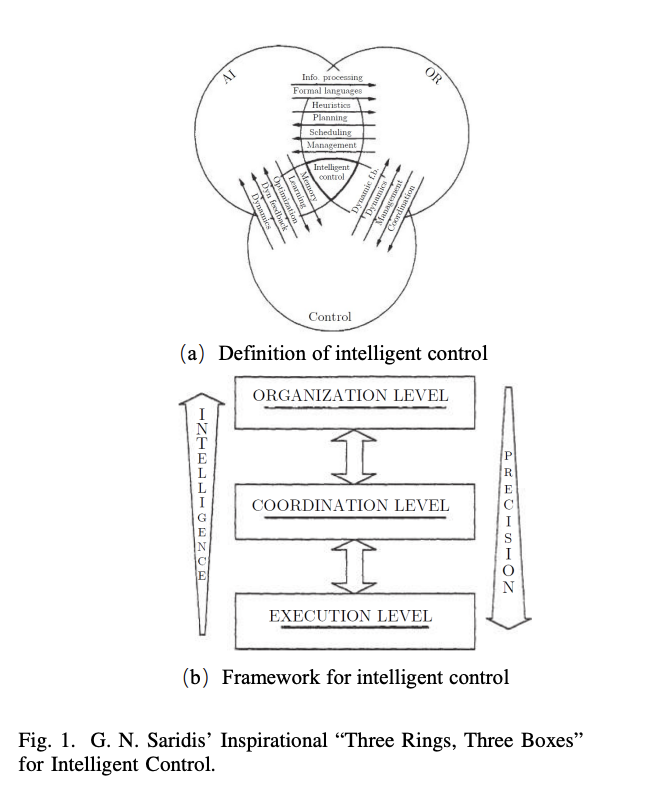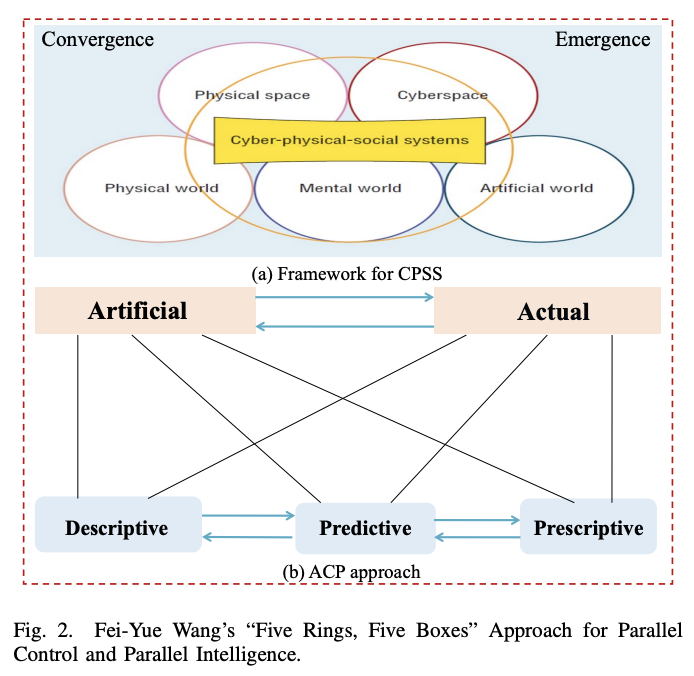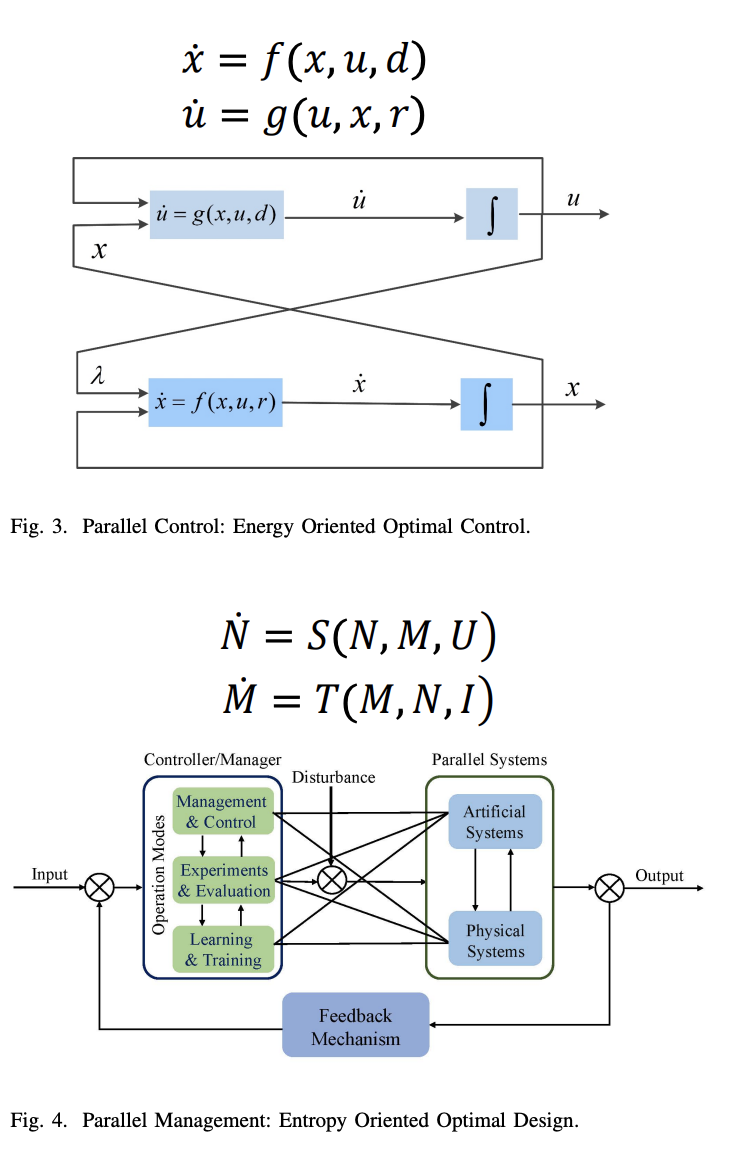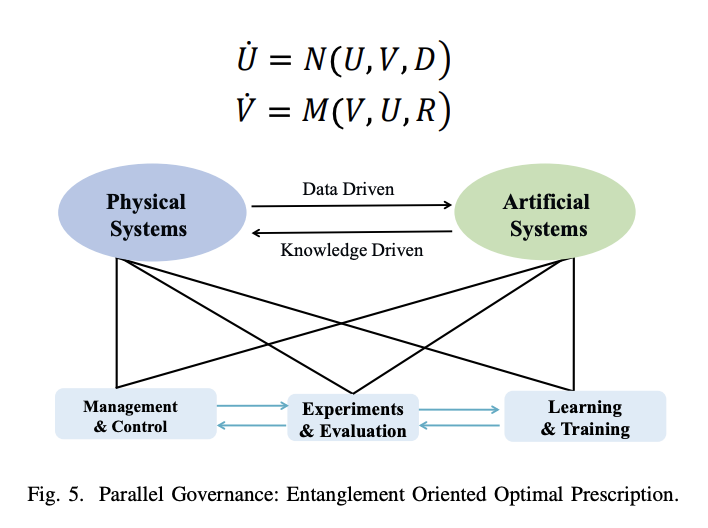博文
面向工业5.0的控制新范式:从大模式到基础控制与基础管理
||
Citation:
F.-Y. Wang, “New control paradigm for Industry 5.0: From big models to foundation control and management,” IEEE/CAA J. Autom. Sinica, vol. 10, no. 8, pp. 1643–1646, Aug. 2023. doi: 10.1109/JAS.2023.123768
New Control Paradigm for Industry 5.0: From Big Models to
Foundation Control and Management
Fei-Yue Wang
面向工业5.0的控制新范式:从大模式到基础控制与基础管理
王飞跃
DO we need a fundamental change in our professional culture and knowledge foundation for control and automation? If so, what are necessary and critical steps we must take to ensure such a change would take place effectively and efficiently, or more general, smoothly and sustainably?
This question has started circulating in my mind two decades ago right after my first two decades of research and development in automation, robotics, intelligent control, and artificial intelligence. By the end of the 20th century, the effort of achieving the initial goal of intelligent control for complex systems, such as intelligent robotic systems and smart human-machine interaction, as envisioned by its pioneers, such as K. S. Fu [1] and G. N. Saridis [2], had seemed run into and stopped by an invisible wall, as witnessed by the fact that the well-known flagship academic gathering in the field, the annual IEEE International Symposium on Intelligent Control (IEEE ISIC), was losing steam after a decade’s rapid rising since 1985 [3]. For those of you interested, related historical reviews and future perspectives can be found in [3]–[5].
The rapid rising of AI during the last decade, especially the recent progress made in deep learning technology, as demonstrated by AlphaGo and ChatGPT [6], [7], has suggested that control and automation do need a fundamental change in their professional culture and knowledge foundation, and I am glad that at IEEE/CAA Journal of Automatica Sinica, a leading effort for such change has been launched intensively since last year [8]–[19], and similar initiatives were also started by other IEEE Transactions and publications [20]–[26]. IEEE/CAA JAS’s recent call for papers on a special issue in Industry 5.0 [27] and its article on steps towards Industry 5.0 are renewed calls for a paradigm shift in control and automation [28].
An entry point for such shift is to move directly from big models or foundation models in cyber physical systems (CPS) to foundation control, foundation management, and foundation governance in cyber physical social systems (CPSS), all for the purpose of knowledge automation for decision intelligence in complex systems. Why and how? Let’s revisit the history and reconsider the future with the help of Norbert Wiener’s circular causality [29].
The Motivation of Intelligent Control
K. S. Fu coined term “Intelligent Control" and defined it as the interaction of Artificial Intelligence and Automatic Control in 1971 [1]. It should be noted that, before him, J. M. Mendel had introduced term “Artificial Intelligence Control" with a proposed content and direction that were almost identical to these of Learning Control [1]–[3]. Fu considered Intelligent Control as a natural extension of Learning Control as new AI method and technology were incorporated and applied into automation, and the ultimate goal of his Intelligent Control should be control like humans, but replace biological humans with robotic humans in automated processes [1], [3]. However, he envisioned an “algorithm of algorithms" approach for Intelligent Control.
After Fu left for research and development in patterns recognition and machine intelligence, his colleague G. N. Saridis led an interdisciplinary effort and opened up a new journey of “system of systems" for Intelligent Control in a hierarchically structured organizational approach along with a complicated decision process, as illustrated by Fig. 1 [2]. Under his effort and leadership, this emerging new field took off in the late 1970s and undergone a rapid growth in the middle 1980s, especially after the creation of IEEE Technical Committee on Intelligent Control and IEEE Workshop on Intelligent Control 1985, which became the annual IEEE International Symposium on Intelligent Control since 1987.

However, due to the historic limitations in thinking and computing, the proposed procedure and architecture for algorithms and systems by both Fu and Saridis were not powerful enough to support a long term sustainable development of Intelligent Control. My own attempt in early 1990s on shadow systems for data generation in intelligent control based on a world model constructed according to Karl Popper's foundation model of the reality, or the big reality model, i.e., the physical world for world 1, the mental world for world 2, the artificial world for world 3, did not attracted much attention [30]. By the end of 1990s, the grand vision of Intelligent Control Systems seemed losing its initial lust and the new effort of using artificial neural networks, as well as fuzzy logic and genetic algorithms, so called computational intelligence approach for Intelligent control started to gain the momentum and popularity, and became mainstream research since.
The Vision of Parallel Control
The journey to Parallel Control was primarily motivated by the lack of data and the high cost, and in many cases no scientific means to conduct actual or physical experiments for verifying or validating governing mechanisms or intelligent control of complex systems. The key to parallel control as well as parallel intelligence is the idea of computational experiments beyond conventional computer simulations, which had been originated from my graduate research in 1982 on experiments for metal imperfection and fatigue in fracture mechanics. This idea was further extended in the late 1980s and the early 1990s to the purpose of generating training data for and building knowledge structures into neural networks by fuzzy reasoning using words, heuristics, and deep modular neuro-fuzzy subnetworks [31]–[33]. Together with the concept of shadow systems, this led naturally to the road of ACP-based parallel control in CPSS for management and control of complex systems in the beginning of the 21st century [34], see Fig. 2 for its basic framework and decision structure.

As pointed out in [8], parallel control and parallel intelligence are linked with Generative Artificial Intelligence intrinsically and naturally, and provide an analytical approach for conducting MetaControl for intelligent control in metaverses and DeMetaControl for intelligent control in decentralized autonomous metaverses based on the new feedback mechanism of circular causality and foundation or big models, which can be summarized mathematically in the following and illustrated briefly in Figs. 3-5, at a three-level abstraction.


The tremendous success of AlphaGo and ChatGPT has greatly enhanced the enthusiasm and energy for advanced works in parallel control and parallel intelligence with easily accessible technological supports, and made the parallel philosophy of living and the technology of digital humans for parallel systems an emerging reality for widespread applications in engineering and social services, which will be addressed briefly in the next section.
The Goal of Foundation Control
I believe that it is time for the next phase of parallel control, to fundation control, foundation management, and foundation governance: implementing K. S. Fu's original vision for intelligent control, but not control liking humans by replacing humans with robots, instead, we would achieve intelligent control as human-like control by augmenting biological humans with both robotical and digital humans, and empowering them with parallel foundation models and updated G. N. Saridis' OCE technologies with Blockchain Intelligence, Smart Contracts, and Decentralized Autonomous Organizations and Operations [4], [28], [35], not just hierarchical structures and distributed AI. The goal and process of Foundation Control, Management, and Governance can be stated shortly as:
• Three Worlds, Three Philosophies. Science and technology alone are not good enough for the new age, we need a new thinking and new philosophy. For this, we can start by adding the third B into the current 2B Western philosophies, i.e., from Being, Becoming, to Believing, and forming the new parallel philosophy through interacting and paralleling three Bs in the three worlds, along with circular consequences of the circular casualty by three categories of knowledge, Descriptive, Predictive, and Prescriptive. Our task is to make this philosophical thinking into a technological reality for foundation control, management, and governance, based on Blockchain, smart contracts, DAO, and DeSci.
• Three Worlds, Three Humans. For the future workforce, we need to develop a parallel population of parallel humans by interacting three types of humans, biological with less than 5%, robotical with less than 15%, and digital with more than 80%. In other words, a biological human would direct 3 robotical and 16 digital ones to ensure the future is still humanity-centric, with an expected increase of 96000% in effectiveness and efficiency for our sustainability.
• Three Worlds, Three Modes. We all go through our each day by Morning (AM), Afternoon (PM), and Evening (EM). A future day in our life and work would be AM for autonomous modes, for more than 80% of our time or about 20 hours of a day, in which we enjoy our life and let the world move autonomously; PM for parallel modes, for less than 15% of our time or about 3 hours of a day, in which we must interact with the world remotely through clouds or telematical operations; and finally EM for expert/emergency modes, for less than 5% of our time or about 1 hour of a day, in which biological humans must be sent through a fast delivery fashion into the field to handle special situations beyond the capacities of foundation models, robotical and digital humans alone. Three types of emerging intelligent technologies are coming to our help, namely, application specific foundation models, scenarios engineering, and humans oriented operating systems.
ACKNOWLEDGMENT: This perspective is a recording of my random thoughts during my visit to the University of Cyprus for IEEE CRFID Distinguished Lecture and my participation in the 31st MED Conference on Control and Automation, IEEE ITSS Workshop on the Road to Emerging Mobility Systems for Smart Cities, in Nicosia, Limassol, Ayia Napa, Cyprus, as well as IFAC World Congress 2023 in Yokohama, Japan. My six presentations in those events have received extremely valuable feedbacks and encouragements. I would like to take this opportunity to express my sincere gratitude and appreciation to Drs Yisheng Lv, Yonglin Tian, and Yutong Wang, and Professors Petros Ioannou, Marios Polycarpou, Jing Sun, Georgios Giannakis, Eskandarian Azim, Karl Johansson, Yaobin Chen, Zhongping Jiang, Youmin Zhang, Qing-Long Han, Carlos Pereira, Larry Stapleton, and Mariana Netto, and many others. This work was partially supported by the Science and Technology Development Fund of Macau SAR (0050/2020/A1).
References
[1] K.-S. Fu, “Learning control systems and intelligent control systems: An intersection of artifical intelligence and automatic control.” IEEE transactions on Automatic Control, vol. 16, no. 1, pp. 70–72, 1971. doi: 10.1109/TAC.1971.1099633
[2] G. N. Saridis, “Toward the realization of intelligent controls,” Proceedings of the IEEE, vol. 67, no. 8, pp. 1115–1133, 1979. doi: 10.1109/PROC.1979.11407
[3] F.-Y. Wang, “Intelligent control in 50 years: From KS Fu’s vision to GN Saridis’ inspiration,” Acta Automatica Sinica, vol. 47, no. 10, pp. 2301–2320, 2021.
[4] J. Yang, X. Wang, Y. Wang et al., “Parallel intelligence and CPSS in 30 years: An ACP approach,” Acta Automatica Sinica, vol. 49, no. 3, pp. 614–634, 2023.
[5] F.-Y. Wang, “Forward to the past: CASTLab’s cyber-social-physical approach for ITS in 1999,” IEEE Intelligent Transportation Systems Magazine, vol. 16, no. 4, pp. 1–4, 2023.
[6] F.-Y. Wang, J. J. Zhang, X. Zheng et al., “Where does AlphaGo go: From Church-Turing thesis to AlphaGo thesis and beyond,” IEEE/CAA Journal of Automatica Sinica, vol. 3, no. 2, pp. 113–120, 2016. doi: 10.1109/JAS.2016.7471613
[7] F.-Y. Wang, Q. Miao, X. Li et al., “What does ChatGPT say: The DAO from algorithmic intelligence to linguistic intelligence,” IEEE/CAA Journal of Automatica Sinica, vol. 10, no. 3, pp. 575–579, 2023. doi: 10.1109/JAS.2023.123486
[8] F.-Y. Wang, “The DAO to Metacontrol for Metasystems in Metaverses: The system of parallel control systems for knowledge automation and control intelligence in CPSS,” IEEE/CAA Journal of Automatica Sinica, vol. 9, no. 11, pp. 1899–1908, 2022. doi: 10.1109/JAS.2022.106022
[9] Y. Wang, Y. Tian et al., “Integrated inspection of QoM, QoP, and QoS for AOI industries in metaverses,” IEEE/CAA Journal of Automatica Sinica, vol. 9, no. 12, pp. 2071–2078, 2022. doi: 10.1109/JAS.2022.106091
[10] Y. Shen, Y. Liu et al., “Parallel sensing in metaverses: Virtual-real interactive smart systems for “6S” sensing,” IEEE/CAA Journal of Automatica Sinica, vol. 9, no. 12, pp. 2047–2054, 2022. doi: 10.1109/JAS.2022.106115
[11] J. Yang, X. Wang et al., “Parallel manufacturing for industrial metaverses: A new paradigm in smart manufacturing,” IEEE/CAA Journal of Automatica Sinica, vol. 9, no. 12, pp. 2063–2070, 2022. doi: 10.1109/JAS.2022.106097
[12] J. Lu, X. Wang et al., “Parallel factories for smart industrial operations: From big AI models to field foundational models and scenarios engineering,” IEEE/CAA Journal of Automatica Sinica, vol. 9, no. 12, pp. 2079–2086, 2022. doi: 10.1109/JAS.2022.106094
[13] X. Wang, M. Kang et al., “DeCASA in agriverse: Parallel agriculture for smart villages in metaverses,” IEEE/CAA Journal of Automatica Sinica, vol. 9, no. 12, pp. 2055–2062, 2022. doi: 10.1109/JAS.2022.106103
[14] F.-Y. Wang, “The Metaverse of Mind: Perspectives on DeSci for DeEco and DeSoc,” IEEE/CAA Journal of Automatica Sinica, vol. 9, no. 12, pp. 2043–2046, 2022. doi: 10.1109/JAS.2022.106106
[15] C. Guo, Y. Lu, Y. Dou, and F.-Y. Wang, “Can ChatGPT boost artistic creation: The need of imaginative intelligence for parallel art,” IEEE/CAA Journal of Automatica Sinica, vol. 10, no. 4, pp. 835–838, 2023. doi: 10.1109/JAS.2023.123555
[16] Q. Miao, W. Zheng, Y. Lv et al., “DAO to HANOI via DeSci: AI paradigm shifts from AlphaGo to ChatGPT,” IEEE/CAA Journal of Automatica Sinica, vol. 10, no. 4, pp. 877–897, 2023. doi: 10.1109/JAS.2023.123561
[17] X. Ge, Q.-L. Han, Q. Wu, and X.-M. Zhang, “Resilient and safe platooning control of connected automated vehicles against intermittent denial-of-service attacks,” IEEE/CAA Journal of Automatica Sinica, vol. 10, no. 5, pp. 1234–1251, 2023. doi: 10.1109/JAS.2022.105845
[18] X. Xue, X. Yu et al., “ChatGPT chats on computational experiments: From interactive intelligence to imaginative intelligence for design of artificial societies and optimization of foundational models,” IEEE/CAA Journal of Automatica Sinica, vol. 10, no. 6, pp. 1357–1360, 2023. doi: 10.1109/JAS.2023.123585
[19] Q.-L. Han, “Driving into future with reliable, secure, efficient and intelligent metavehicles,” IEEE/CAA Journal of Automatica Sinica, vol. 10, no. 6, pp. 1355–1356, 2023. doi: 10.1109/JAS.2023.123621
[20] F.-Y. Wang, Y. Tang, and P. J. Werbos, “Guest editorial: Cyber–physical–social intelligence: Toward metaverse-based smart societies of 6I and 6S,” IEEE Transactions on Systems, Man, and Cybernetics: Systems, vol. 53, no. 4, pp. 2018–2024, 2023. doi: 10.1109/TSMC.2023.3243558
[21] J. Li, R. Qin et al., “The future of management: DAO to smart organizations and intelligent operations,” IEEE Transactions on Systems, Man, and Cybernetics: Systems, vol. 53, no. 6, pp. 3389–3399, 2023. doi: 10.1109/TSMC.2022.3226748
[22] J. Wang, Y. Tian, Y. Wang et al., “A framework and operational procedures for metaverses-based industrial foundation models,” IEEE Transactions on Systems, Man, and Cybernetics: Systems, vol. 53, no. 4, pp. 2037–2046, 2022.
[23] Y. Liu, Y. Shen, Y. Tian, Y. Ai, B. Tian, E. Wu, and L. Chen, “Radarverses in metaverses: A CPSI-based architecture for 6S radar systems in CPSS,” IEEE Transactions on Systems, Man, and Cybernetics: Systems, vol. 53, no. 4, pp. 2128–2137, 2022.
[24] D. Cao, X. Wang, L. Li et al., “Future directions of intelligent vehicles: Potentials, possibilities, and perspectives,” IEEE Transactions on Intelligent Vehicles, vol. 7, no. 1, pp. 7–10, 2022. doi: 10.1109/TIV.2022.3157049
[25] Z. Zhu, X. Wang, Y. Zhao et al., “Crowdsensing intelligence by decentralized autonomous vehicles organizations and operations,” IEEE Transactions on Intelligent Vehicles, vol. 7, no. 4, pp. 804–808, 2022. doi: 10.1109/TIV.2022.3224918
[26] J. Wang, X. Wang, T. Shen et al., “Parallel vision for long-tail regularization: Initial results from IVFC autonomous driving testing,” IEEE Transactions on Intelligent Vehicles, vol. 7, no. 2, pp. 286–299, 2022. doi: 10.1109/TIV.2022.3145035
[27] F.-Y. Wang, J. Yang, X. Wang et al., “Chat with chatGPT on Industry 5.0: Learning and decision-making for intelligent industries,” IEEE/CAA Journal of Automatica Sinica, vol. 10, no. 4, pp. 831–834, 2023. doi: 10.1109/JAS.2023.123552
[28] X. Wang, J. Yang, Y. Wang et al., “Steps toward Industry 5.0: Building “6S” parallel industries with cyber-physical-social intelligence,” IEEE/CAA Journal of Automatica Sinica, 2023, doi: 10.1109/JAS.2023.123753.
[29] F.-Y. Wang, “Parallel management: The DAO to smart ecological technology for complexity management intelligence,” Acta Automatica Sinica, vol. 48, no. 11, pp. 2655–2669, 2022.
[30] F.-Y. Wang, “Shadow systems: A new concept for nested and embedded co-simulation for intelligent systems, ” Tucson, Arizona, USA: University of Arizona, 1994.
[31] F.-Y. Wang and M. Jamshidi, “Building knowledge structure in neural nets using fuzzy logic, ” in Robotics and Manufacturing: Recent Trends in Research, Education and Applications. ASME Press, 1992, pp. 361–369.
[32] F.-Y. Wang, “Modeling, analysis and synthesis of linguistic dynamic systems: A computational theory, ” in Proceedings of the IEEE International Workshop on Architecture for Semiotic Modeling and Situation Control in Large Complex Systems, 1995, pp. 173–178.
[33] F.-Y. Wang and H.-m. Kim, “Implementing adaptive fuzzy logic controllers with neural networks: A design paradigm,” Journal of Intelligent & Fuzzy Systems, vol. 3, no. 2, pp. 165–180, 1995.
[34] F.-Y. Wang, “Parallel system methods for management and control of complex systems,” Control and Decision., vol. 19, no. 5, pp. 485–489, 2004.
[35] F.-Y. Wang, “Parallel doctors and parallel hospitals: Impact and perspective of ChatGPT-like AIGC and AGI on medicine and medicare,” Medical Journal of Peking Union Medical College Hospital, vol. 14, no. 4, 2023
https://m.sciencenet.cn/blog-2374-1409688.html
上一篇:[转载]【CAC2023专题论坛】“联邦生态·平行未来”论坛亮点纷呈,邀您共享盛会!
下一篇:[转载]JAS 72名专家入选科睿唯安2023年度高被引科学家